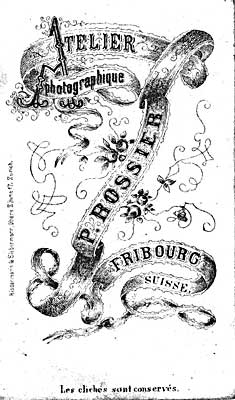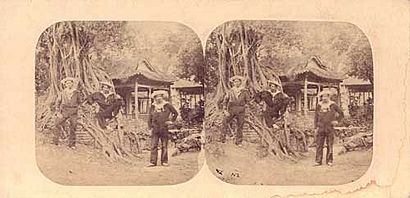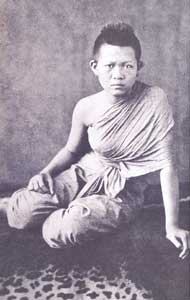Pierre Rossier facts for kids
Pierre Joseph Rossier (born July 16, 1829 – died October 22, 1886) was a very important Swiss photographer. He was one of the first to take photos in many parts of the world. His pictures included portraits of people, city views, and beautiful landscapes. He used a special old photography method called albumen printing. This allowed him to create different types of photos, like stereographs (which look 3D) and cartes-de-visite (small portrait cards).
A company in London called Negretti and Zambra hired him for a big job. They wanted him to travel to Asia and take pictures of the Second Opium War. Even though he didn't get to join the soldiers, he stayed in Asia for several years. During this time, he took the very first commercial photographs of China, the Philippines, Japan, and Siam (which is now Thailand). He was also the first professional photographer to work in Japan. There, he taught photography to important early Japanese photographers like Ueno Hikoma, Maeda Genzō, and Horie Kuwajirō. Later, back in Switzerland, he opened his own photographic studios in Fribourg and Einsiedeln. Pierre Rossier is remembered for his amazing photos and for teaching others how to capture the world through a lens.
Contents
Who Was Pierre Rossier?
For a long time, not much was known about Pierre Rossier. People didn't even know his first name! Sometimes he was called "P. Rossier" and other times "M. Rossier." But recently, old papers found in the town of Fribourg showed his name was Pierre. The "M" probably stood for "Monsieur", which means "Mr." in French.
Many thought he was from France, and in Japan, some even called him "English." However, new research shows he was Swiss. He was born on July 16, 1829, in a small village called Grandsivaz in the Canton of Fribourg. His family were farmers and didn't have much money. Pierre was the fourth of ten children. When he was 16, he became a teacher in a nearby village. But by 1855, he got a passport to visit France and England to work as a photographer.
After leaving Switzerland and arriving in England, the company Negretti and Zambra hired Rossier. They wanted him to go to China to photograph the Second Opium War (1858–1860). The company might have thought his Swiss citizenship was helpful for this trip. Switzerland is a neutral country, so his nationality might have made it easier for him to travel on British or French ships. This was a very important job, costing a lot of money and having many risks for Rossier.
Rossier's Asia Photos
Pierre Rossier arrived in Hong Kong in 1858. Soon after, he started taking many photos, mostly in and around Canton (now called Guangzhou). In November 1859, Negretti and Zambra published 50 of Rossier's pictures, including some stereographs. These photos received good reviews in photography magazines at the time.
In 1858 or 1859, Rossier traveled to the Philippines. There, he visited and photographed the Taal Volcano. By 1859, Rossier was in Japan. He took pictures first in Nagasaki, then in Kanagawa, Yokohama, and Edo (now Tokyo). He was the first professional photographer to arrive in Japan. One famous photo he took in Nagasaki in the summer of 1859 was a portrait of Philipp Franz von Siebold's son, Alexander, with a group of samurai warriors.
By June 1860, Rossier was in Shanghai. He probably went there to try and get permission to join the Anglo-French military group. This group had already arrived in northern China for the Second Opium War. If he tried, he didn't succeed. Both the British and French armies had already hired other photographers. Even though Rossier couldn't join the mission he was hired for, he stayed in East Asia for a while longer.
In October 1860, Rossier returned to Nagasaki. He took photos of the harbor for the British Consul, George S. Morrison, and was paid $70 for them. Negretti and Zambra advertised Rossier's photos of Japan in 1860. However, they didn't publish them until October or November 1861. Some of Rossier's Japan photos appeared earlier in books. Five were in George Smith's book, Ten Weeks in Japan, in April 1861. In July, eight more appeared as lithographs in Henry Arthur Tilley's book, Japan, the Amoor, and the Pacific. An 1861 edition of the Illustrated London News also showed some of his pictures of daily life in China. One of the photos Negretti and Zambra advertised in 1860 became the first commercial photo from Japan to be published. It is also the earliest known hand-coloured Japanese photograph.
Thanks to old documents, we now know for sure that Rossier took Negretti and Zambra's photos of China and Japan. But for many years, people thought they might have been taken by other photographers.
Teaching Photography in Japan
Rossier arrived in Japan in 1859. At that time, people in Kyūshū, especially Nagasaki, were just starting to experiment with photography. Nagasaki was a center for rangaku, which was the study of Western science. Doctors like Jan Karel van den Broek and J. L. C. Pompe van Meerdervoort taught their Japanese students not only medicine but also chemistry and photography. These doctors were not expert photographers, and their attempts to take pictures often failed. Still, they taught a photography method called the wet-collodion process to students like Maeda Genzō, Ueno Hikoma, and Horie Kuwajirō.
When Rossier arrived in Japan, he likely introduced himself as a photographer sent by Negretti and Zambra. This might be why he was often called an "English" photographer while he was there. In Nagasaki, Maeda Genzō helped Rossier with his work. Maeda had been told to go with the "Englishman" and learn more about photography. With Maeda and other students, Rossier took photos of priests, beggars, sumo matches, and the foreign settlement. He also took the group photo of Alexander von Siebold and the samurai.
Rossier thought that the doctors' photography failures were because they didn't have the right chemicals. So, he gave Maeda a letter to help him get photographic equipment and chemicals from Shanghai. Both Maeda and another student, Furukawa, bought lenses, chemicals, and special paper through Rossier.
Ueno Hikoma and Horie Kuwajirō also learned photography from Rossier. Ueno had originally wanted to learn how to make cameras, not just take pictures. But meeting Rossier seemed to convince Ueno to become a photographer. He was so amazed by the camera's technology that he quickly gave up on making one himself. Within a few months, he and Horie bought a French camera and chemicals. After that, they started their own photography careers.
Even though Rossier was in Japan for a short time and not many of his photos from that period still exist, he had a big impact on photography in the country.
Rossier's Later Life
In 1861, Rossier was in Siam (Thailand). He helped a French zoologist named Firmin Bocourt by taking ethnographic portraits. These were pictures of people from different cultures for Bocourt's science trip in 1861–1862. In 1863, Negretti and Zambra released 30 stereographic portraits and landscapes taken in Siam. These were almost certainly taken by Rossier. In February 1862, Rossier was back in Shanghai. He sold his cameras and other photo gear before sailing back to Europe. It's possible Rossier also took photos in India during his time in Asia. Negretti and Zambra released some views of India around the same time as his China photos.
Rossier returned to Switzerland in early 1862. In October 1865, he married Catharine Barbe Kaelin. They had a son, Christophe Marie Pierre Joseph, born in July 1866. Sadly, Catharine died in April 1867.
Rossier kept a photographic studio in Fribourg until at least 1876. He also had a studio in Einsiedeln. In the 1860s and 1870s, he took many stereographs and cartes-de-visite. These included portraits and views of Fribourg, Einsiedeln, and other places in Switzerland. In 1871, an advertisement in a Fribourg newspaper offered photos by Rossier of religious paintings. In 1872, Rossier applied for a passport to travel to France, where he might have taken more pictures.
At some point between 1871 and 1884, he married again. His second wife, Marie Virginie Overney, worked for his studio's landlords. They had a son, Joseph Louis, born in Paris in March 1884. This son later owned a café in Vevey, Switzerland. Pierre Rossier passed away in Paris sometime between 1883 and 1898.
Rossier's Lasting Impact
You can find examples of Rossier's photos of Switzerland in several museums and private collections there. His first commercial photos of China and Japan are now quite rare. He sometimes complained that the weather in Asia damaged his photo chemicals. Some of his negatives might have been harmed on their way to London from Asia.
Even though not many of his original images from Asia still exist, his importance to the early history of photography there is huge. Before he arrived in Japan in 1859, Japanese students struggled to take good photos. But Rossier's experience, his teaching, and his connections to suppliers of photo materials were extremely helpful. He played a key role in helping Japan develop its own strong photography tradition.





